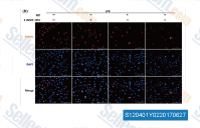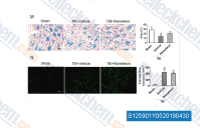
- Inhibitors
- By product type
- Natural Products
- Inducing Agents
- Peptides
- Antibiotics
- Antibody-drug Conjugates(ADC)
- PROTAC
- Hydrotropic Agents
- Dyes
- By Signaling Pathways
- PI3K/Akt/mTOR
- Epigenetics
- Methylation
- Immunology & Inflammation
- Protein Tyrosine Kinase
- Angiogenesis
- Apoptosis
By research - Antibodies
- Compound Libraries
- Popular Compound Libraries
- Customize Library
- Clinical and FDA-approved Related
- Bioactive Compound Libraries
- Inhibitor Related
- Natural Product Related
- Metabolism Related
- Cell Death Related
- By Signaling Pathway
- By Disease
- Anti-infection and Antiviral Related
- Neuronal and Immunology Related
- Fragment and Covalent Related
- FDA-approved Drug Library
- FDA-approved & Passed Phase I Drug Library
- Preclinical/Clinical Compound Library
- Bioactive Compound Library-I
- Bioactive Compound Library-II
- Kinase Inhibitor Library
- Express-Pick Library
- Natural Product Library
- Human Endogenous Metabolite Compound Library
- Alkaloid Compound LibraryNew
- Angiogenesis Related compound Library
- Anti-Aging Compound Library
- Anti-alzheimer Disease Compound Library
- Antibiotics compound Library
- Anti-cancer Compound Library
- Anti-cancer Compound Library-Ⅱ
- Anti-cancer Metabolism Compound Library
- Anti-Cardiovascular Disease Compound Library
- Anti-diabetic Compound Library
- Anti-infection Compound Library
- Antioxidant Compound Library
- Anti-parasitic Compound Library
- Antiviral Compound Library
- Apoptosis Compound Library
- Autophagy Compound Library
- Calcium Channel Blocker LibraryNew
- Cambridge Cancer Compound Library
- Carbohydrate Metabolism Compound LibraryNew
- Cell Cycle compound library
- CNS-Penetrant Compound Library
- Covalent Inhibitor Library
- Cytokine Inhibitor LibraryNew
- Cytoskeletal Signaling Pathway Compound Library
- DNA Damage/DNA Repair compound Library
- Drug-like Compound Library
- Endoplasmic Reticulum Stress Compound Library
- Epigenetics Compound Library
- Exosome Secretion Related Compound LibraryNew
- FDA-approved Anticancer Drug LibraryNew
- Ferroptosis Compound Library
- Flavonoid Compound Library
- Fragment Library
- Glutamine Metabolism Compound Library
- Glycolysis Compound Library
- GPCR Compound Library
- Gut Microbial Metabolite Library
- HIF-1 Signaling Pathway Compound Library
- Highly Selective Inhibitor Library
- Histone modification compound library
- HTS Library for Drug Discovery
- Human Hormone Related Compound LibraryNew
- Human Transcription Factor Compound LibraryNew
- Immunology/Inflammation Compound Library
- Inhibitor Library
- Ion Channel Ligand Library
- JAK/STAT compound library
- Lipid Metabolism Compound LibraryNew
- Macrocyclic Compound Library
- MAPK Inhibitor Library
- Medicine Food Homology Compound Library
- Metabolism Compound Library
- Methylation Compound Library
- Mouse Metabolite Compound LibraryNew
- Natural Organic Compound Library
- Neuronal Signaling Compound Library
- NF-κB Signaling Compound Library
- Nucleoside Analogue Library
- Obesity Compound Library
- Oxidative Stress Compound LibraryNew
- Plant Extract Library
- Phenotypic Screening Library
- PI3K/Akt Inhibitor Library
- Protease Inhibitor Library
- Protein-protein Interaction Inhibitor Library
- Pyroptosis Compound Library
- Small Molecule Immuno-Oncology Compound Library
- Mitochondria-Targeted Compound LibraryNew
- Stem Cell Differentiation Compound LibraryNew
- Stem Cell Signaling Compound Library
- Natural Phenol Compound LibraryNew
- Natural Terpenoid Compound LibraryNew
- TGF-beta/Smad compound library
- Traditional Chinese Medicine Library
- Tyrosine Kinase Inhibitor Library
- Ubiquitination Compound Library
-
Cherry Picking
You can personalize your library with chemicals from within Selleck's inventory. Build the right library for your research endeavors by choosing from compounds in all of our available libraries.
Please contact us at info@selleckchem.com to customize your library.
You could select:
- Bioreagents
- qPCR
- 2x SYBR Green qPCR Master Mix
- 2x SYBR Green qPCR Master Mix(Low ROX)
- 2x SYBR Green qPCR Master Mix(High ROX)
- Protein Assay
- Protein A/G Magnetic Beads for IP
- Anti-DYKDDDDK Tag magnetic beads
- Anti-DYKDDDDK Tag Affinity Gel
- Anti-Myc magnetic beads
- Anti-HA magnetic beads
- Poly DYKDDDDK Tag Peptide lyophilized powder
- Protease Inhibitor Cocktail
- Protease Inhibitor Cocktail (EDTA-Free, 100X in DMSO)
- Phosphatase Inhibitor Cocktail (2 Tubes, 100X)
- Cell Biology
- Cell Counting Kit-8 (CCK-8)
- Animal Experiment
- Mouse Direct PCR Kit (For Genotyping)
- Featured Products
- MRTX1133
- Nab-Paclitaxel
- KP-457
- IAG933
- RMC-6236 (Daraxonrasib)
- RMC-7977
- Zoldonrasib (RMC-9805)
- GsMTx4
- Navitoclax (ABT-263)
- TSA (Trichostatin A)
- Y-27632 Dihydrochloride
- SB431542
- SB202190
- MK-2206 Dihydrochloride
- LY294002
- Alisertib (MLN8237)
- XAV-939
- CHIR-99021 (Laduviglusib)
- Bafilomycin A1 (Baf-A1)
- Thiazovivin (TZV)
- CP-673451
- Verteporfin
- DAPT
- Galunisertib (LY2157299)
- MG132
- SBE-β-CD
- Tween 80
- Bavdegalutamide (ARV-110)
- Z-VAD-FMK
- Wnt-C59 (C59)
- IWR-1-endo
- (+)-JQ1
- 3-Deazaneplanocin A (DZNep) Hydrochloride
- RepSox (E-616452)
- Erastin
- Q-VD-Oph
- Puromycin Dihydrochloride
- Cycloheximide
- Telaglenastat (CB-839)
- A-83-01
- Ceralasertib (AZD6738)
- Liproxstatin-1
- Emricasan (IDN-6556)
- PMA (Phorbol 12-myristate 13-acetate)
- Dibutyryl cAMP (Bucladesine) sodium
- Nedisertib (M3814)
- PLX5622
- IKE (Imidazole Ketone Erastin)
- STM2457
- Saruparib (AZD5305)
- New Products
- Contact Us
MT Receptor
GPCR & G Protein
Isoform-selective Products
- All (5)
- MT Receptor Antagonist (1)
- MT Receptor Agonists (4)
- New MT Receptor Products
| Cat.No. | Product Name | Information | Product Use Citations | Product Validations |
|---|---|---|---|---|
| S1204 | Melatonin | Melatonin is a MT receptor agonist, used as a dietary supplement. This compound is a selective ATF-6 inhibitor and downregulates COX-2. It enhances mitophagy and regulates the homeostasis of apoptosis and autophagy. |

|
|
| S1259 | Ramelteon | Ramelteon (TAK-375) is a novel melatonin receptor agonist for human MT1 and MT2 receptors and chick forebrain melatonin receptors with Ki of 14 pM, 112 pM and 23.1 pM, respectively. |

|
|
| S3584 | Luzindole | Luzindole (N-0774, N-acetyl-2-benzyltryptamine) is a selective melatonin receptor antagonist with Kis of 179 nM for MT1 and 7.3 nM for MT2, respectively. | ||
| S4281 | Tasimelteon | Tasimelteon (BMS 214778, VEC 162) is a selective dual melatonin receptor (MT1/MT2) agonist with 2.1-4.4 times greater affinity for the MT2 receptor believed to mediate circadian rhythm phase-shifting (Ki = 0.0692 nM and Ki = 0.17 nM in NIH-3T3 and CHOeK1 cells, respectively), than for the MT1 receptor (Ki = 0.304 nM and Ki = 0.35 nM, respectively). | ||
| E6011 | Agomelatine hydrochloride | Agomelatine hydrochloride (S-20098 hydrochloride) is a specific agonist of MT1 and MT2 receptors with Kis of 0.1, 0.06, 0.12, and 0.27 nM for CHO-hMT1, HEK-hMT1, CHO-hMT2, and HEK-hMT2, respectively. It is also a selective antagonist of 5-HT2C receptors with pKis of 6.4 and 6.2 at native (porcine) and cloned, human 5-HT2C receptors, respectively. Blockade of these receptors enhances adrenergic and dopaminergic transmission in the frontocortical regions. | ||
| S3584 | Luzindole | Luzindole (N-0774, N-acetyl-2-benzyltryptamine) is a selective melatonin receptor antagonist with Kis of 179 nM for MT1 and 7.3 nM for MT2, respectively. | ||
| S1204 | Melatonin | Melatonin is a MT receptor agonist, used as a dietary supplement. This compound is a selective ATF-6 inhibitor and downregulates COX-2. It enhances mitophagy and regulates the homeostasis of apoptosis and autophagy. |

|
|
| S1259 | Ramelteon | Ramelteon (TAK-375) is a novel melatonin receptor agonist for human MT1 and MT2 receptors and chick forebrain melatonin receptors with Ki of 14 pM, 112 pM and 23.1 pM, respectively. |

|
|
| S4281 | Tasimelteon | Tasimelteon (BMS 214778, VEC 162) is a selective dual melatonin receptor (MT1/MT2) agonist with 2.1-4.4 times greater affinity for the MT2 receptor believed to mediate circadian rhythm phase-shifting (Ki = 0.0692 nM and Ki = 0.17 nM in NIH-3T3 and CHOeK1 cells, respectively), than for the MT1 receptor (Ki = 0.304 nM and Ki = 0.35 nM, respectively). | ||
| E6011 | Agomelatine hydrochloride | Agomelatine hydrochloride (S-20098 hydrochloride) is a specific agonist of MT1 and MT2 receptors with Kis of 0.1, 0.06, 0.12, and 0.27 nM for CHO-hMT1, HEK-hMT1, CHO-hMT2, and HEK-hMT2, respectively. It is also a selective antagonist of 5-HT2C receptors with pKis of 6.4 and 6.2 at native (porcine) and cloned, human 5-HT2C receptors, respectively. Blockade of these receptors enhances adrenergic and dopaminergic transmission in the frontocortical regions. |






































